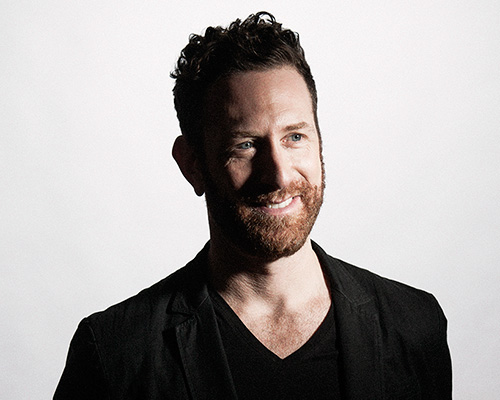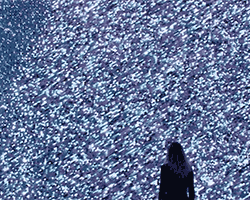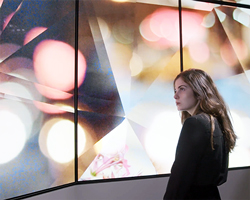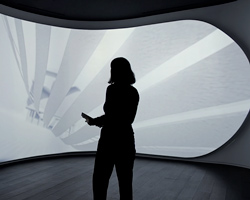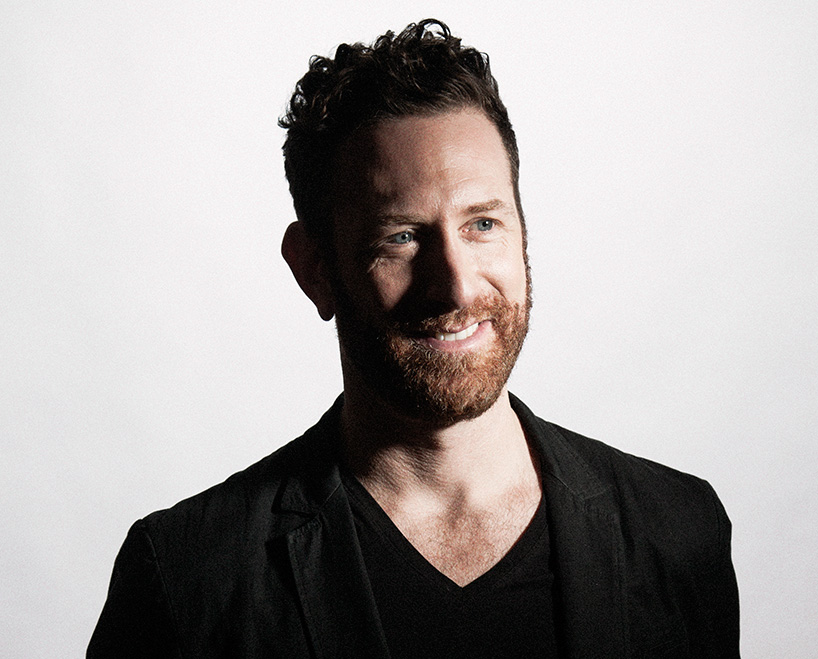
david schwarz photographed by charlie wan
david schwarz is the creative leader and founding partner of hush, a design agency based in brooklyn, new york. david has spent over a decade working with brands to design valuable experiences using content, interactivity, architecture and technology.
designboom: what originally made you want to become a designer?
david schwarz: I was always interested in designing things, but for a long time I didn’t really know that there was an actual practice called design. I knew that people grew up and went to work and made things but not much more. as I got older, I learned more and was able to apprentice for some architects, meet some ‘real’ graphic designers, etc. but I didn’t understand it as a true way of thinking about the world – I just saw output. I saw graphics, moving images, furniture, structures, but I didn’t know the thinking and process that comes first. I certainly didn’t understand the business of design either.
the journey was a pretty normal curve until after college. I studied some architectural history and studio art in college, but went on to do an intensive summer program at harvard’s GSD immediately after graduation. I worked all day and night, and fell in love with the practice of architecture under the tutelage of a great professor (who is now a business mentor) as I built my first real portfolio. I also sat in an auditorium with hundreds of other students as richard meier told us that the architectural profession is terrible and to get out while we still can.
despite my energy and enthusiasm for the profession, a move to sf during the height of the dot-com boom directed my focus elsewhere – towards a new form of ‘digital” architecture and the designing and building of the early consumer web. I felt a kinship with early digital in that the nomenclature and thought process of designing a building for people to enter was similar to designing the virtual interface. it was still about people and movement through a space – albeit one of pixels, not materials.
to dive into design in earnest, I got a scholarship to art center college of design in la and joined the graduate media design program there. I studied a variety of things, but most notably film, motion and interactive design – and where they intersect. I put architecture aside for the moment as these new pursuits were just as exciting to me. after graduation and many years in the freelance market as a designer / director, I met my business partner and we put a stake in the ground and called it… hush.
niketown NYC – ‘super bowl installation’
DB: how would you describe your approach to design?
DS: I try not to overthink things. a good idea is a good idea – the more simple, the better. as a creative leader, I work with our creative director and hush management teams to find the trees in the forest, to separate what’s valuable from what’s cool, and to pull out that single piece of an idea that does everything we need to do. I think that’s the value of experience – you can identify what works very quickly and discard all the rest.
this doesn’t mean we forgo rigor. this just means that once we see ‘the thing,’ we iterate endlessly around that focus. we rarely do ‘three ideas’ or a 50 page deck of ‘options.’ instead, we present ‘the thing’ we believe is true, right, honest and valuable to the design challenge at hand.
DB: who or what has been the biggest single influence on your way of thinking?
DS: the idea of a singular influence is simply impossible – there are just too many diverse forces in design to take inspiration from one source. in fact, I think design is a process of clearing away all of these influences, curating all the chatter and really figuring out what moves you in a substantive way, not just a cool way. there are a million cool things. I believe in power and longevity and being inspired by artists who have consistently delivered that. to name a few: lewitt, albers, rams, the eames, mies, kubrick, serra, turrell, rothko, flavin, ryoji ikeda, cope, saccenti, iwan baan, eliasson…
for me, and at hush in general, graphic design is challenged by everything not graphic design – the other disciplines of design, art, architecture, code, film. if you look at the work in those surrounding fields, they continually criss cross the field of traditional graphic design and in many cases, simply blow it up. at this point in my career, I have a love-hate relationship with the traditions of graphic design. the principles are sound, but we simply work in so many dynamic practices, from the worlds of creative code to parametric architecture to motion, that these traditions are continually uprooted – and rightly so.
underarmour china experience
DB: what is your strongest skill?
DS: my approach is one that tries to balance creative goals with the business requirements that allow those goals to be achieved. that’s my core role at hush.
I grew up in an entrepreneurial family, I studied economics and business. I balanced my own bank account. this, in conjunction with studying the artistic aspects of design and design thinking, helped me juggle my two brains. some would consider this a weakness – a lack of the ability to be completely hellbent on one or the other, to be all-consumed. but I’ve made it my greatest asset, because I believe they are inextricably linked in the kind of work we create and the kind of problems we’re asked to solve.
DB: what type of brief or project do you enjoy working on the most?
DS: the more complex the better. there’s an infinite amount of possibility in any single discipline – the 16:9 frame of film, the canvas of graphic design, the 3d space of architectural form, the ephemeral 1s and Os of code and technology. any single one is worth a lifetime of effort. but what I love, and where our agency really excels, is where those disciplines crash into each other, influencing each other, pushing and pulling, causing turbulence. our ability to harness that turbulence marks hush’s best work. it also happens to be why clients hire us.
IBM video wall at the US open 2013
DB: what are your thoughts on specialization vs generalization?
DS: hush is a renaissance-minded company. we’ll always hire the savvy generalist over the rock star specialist. I personally believe people (and therefore companies) are more interesting with these kinds of minds at the helm. the ecosystem within brands and their competitive landscape is incredibly complex. it’s rarely static and it can be highly opaque. if I was a brand leader, I would engage companies that consist of the most diverse and nimble thinkers out there, who can zig when most zag. so, that’s the kind of company we’ve built.
DB: how do you think online design resources have influenced the design being produced today?
DS: in a big way. net positive – but troublesome.
I appreciate them as tools and I go to countless sources on any given week. I love the ubiquity and accessibility and that’s an undeniable net positive for the design industry. more ways to publish work, more ways to see important work, and more ways to make intellectual leaps. I love the ease of search, find, pin, share. but I’ve learned to use them as means to an end, to help formulate a point of view and to understand contemporary trends, behaviors and connections that is of value to our clients.
however, when you look at folks coming out of school these days, their portfolios look oddly similar. same typefaces. same materials. same layouts. same plug-ins. same ‘case study’ brands. they’ve all spent hours on the notable blogs and their personal voice has become devoured by trend. it’s impossible not to get swept away with the aesthetic tide. and it most often happens to young designers. I think this is a result of not having to look ‘hard’ and having everything a click away. I certainly don’t want to sound like a luddite, but the effort put in to find the things that are important to you is half the battle. if it doesn’t require any work, then everyone ends up in the same place – on the easiest path.
google ‘chrome racer installation’
DB: what is something that you are currently fascinated by and how is it feeding into your work?
DS: I’ve always been fascinated by the human mind and how it works for us and against us – how it can be incredibly powerful, but also highly uncontrollable. whenever someone asks me what I would be doing if I wasn’t doing what I’m doing, I say the same thing: psychologist.
a few months ago I was at a conference and a professor from columbia spoke about his study of the human brain as it relates to the nebulous idea of ‘inspiration.’ he’s been looking at how the brain actually reacts when people say they are inspired. he uses electromagnetic pulses and scans captured while people are problem solving and performing mental puzzles. in parallel he was researching historic tales of inspiration, renowned ‘ah ha’ moments. edison. napoleon. newton. those kinds of moments.
in short, he found that the mind has very distinct electrical patterns during moments of inspiration. moments of inspiration are neither left-brained nor right-brained despite the traditional idea of people being ‘rational’ or ‘artistic.’ they are always all-brained. the left and right brain separation is a myth. this was a huge motivator for me, as I’ve always believed everything is interconnect and interdependent.
all of this feeds into our work at hush in a very specific way. it had been a long time coming, but we finally did away with ‘brainstorming” sessions in the traditional sense. why? the professor proved something scientifically that we had been feeling internally, but couldn’t rationalize. he posited that the idea of getting a team together for a ‘brainstorming’ session to come up with great ideas is useless because inspiration doesn’t work like that. brains need white space, emptiness and a level of distraction to be innovative – none of which exists when you gather people around a white board to generate ideas under intense time pressure and deadlines.
so, we changed our process. there’s still a lot of people and white boards and scribbles, but the goals for those sessions are much different. we brief people together, present together, and iterate together. but we leave more ‘white space’ in between for people to find their inspiration in the moments and cadence that work best for the human brain.
exxon mobile ‘upper zakum’
DB: what are you passionate about besides your work?
DS: I’m running the NYC marathon on nov 2. I wouldn’t normally say that running is a ‘passion’ but the sheer amount of training required seems to put it in that camp. specifically, what I’m passionate about is the rigor and the regimen. everyone juggles a million things a day, so to break through all of that and commit to hours alone on the road with just your thoughts is a feat in itself – especially at 5 am. the accomplishment I feel when I walk into work having already run a bunch of miles gives my day a momentum that I’ve never had before. and that rigor / regimen thing is very applicable to all the other parts of design. there are no shortcuts.
I’m also running on behalf of an amazing charity called freearts NYC that provides underserved children and families with a unique combination of educational arts and mentoring programs. anyone can donate to them on my behalf. please do!
DB: do you have any superstitious beliefs or rules that you live by?
DS: I played baseball growing up and there aren’t any athletes more superstitious than baseball players. lucky socks. practice swings. rally caps. it’s all still with me, just in different forms. what was superstition driving quirky behavior on the baseball field has become regimen and rigor in adulthood.
I believe in practice. I’ve never been the most talented person out there, but I’ve out-practiced and out-trained a lot of people. you can’t wing it and make it good. you have to put in the work – so put in the work! I take all of my professional ‘at bats’ very seriously, and I make sure our team does as well. you really only get one chance to convince people of an idea, and even the greatest ideas can die hard if presented poorly.
NIKE victory camp
DB: what’s the best piece of advice you have heard?
DS: I was just at a conference last week and I heard a ton of great advice, and many one-liners that are unforgettable. the one that stuck with me was said by john maeda during a roundtable discussion. truthfully, I think he was just the conduit as he was repeating a quote from w+k’s john jay:
‘the most powerful thing you can be in the world is yourself.’
this stood out to me. we work in an industry that is highly competitive and saturated. our market is defined by some of the most talented people and companies in the world in terms of design and innovation. it’s healthy to be competitive, but we need to remember that each of us, and our organizations, are defined by our unique, powerful traits. the path to the most success and happiness is harnessing the innate powers we already have, not longing to be who we’re not.
DB: what’s your personal motto?
DS: ‘do it once, do it right.’
GRAPHIC STUDIO INTERVIEWS (193)
HUSH (4)
PRODUCT LIBRARY
a diverse digital database that acts as a valuable guide in gaining insight and information about a product directly from the manufacturer, and serves as a rich reference point in developing a project or scheme.
